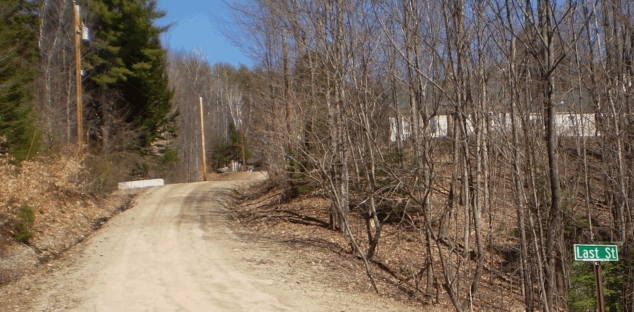
Before leaving the area of the Andover/Franklin town line, I’d like to write about Last Street. For most of its existence, this road was unnamed, and there was only one house on it. Ralph Chaffee, in his 1974 book East Andover and Its People, tells of the historical significance of this particular house. It is a so-called “plank” house – one of only a few in town. The outside walls of a plank house are built of vertical planks rather than boarded studding, which was more commonly used.
The house may have been built by early settler John Sawyer (1771-1840) or by his son Josiah Sawyer (1808-1880) who lived there for many years. The house sits on the hill, overlooking Sucker Brook and the valley below. To gain access to this land, it was necessary for the settlers to cross the brook. At first, they probably forded the waterway as best they could. Later on, they may have built a pole bridge, and eventually one that was made from sawed planks and timbers.
In 1881, Charles C. Davis, a storekeeper and Andover selectman, became the new owner. His widow inherited the homestead in 1901, and eventually it became the home of her daughter, Ella Morey. Mrs. Morey and her hired hand, Herb Getchell, were living there in 1929, when my parents became their new neighbors. Ella Morey and Herb Getchell both died in 1945 – she at age 92, and he at age 70.
An estate auction was held following Mrs Morey’s death. My parents attended the auction and bought a beautiful old bureau which we always referred to as “Mrs. Morey’s bureau.” It became a beloved piece of furniture in our household, and after 50 years it became the cherished possession of my niece.
I was too young to remember the auction, but my sister Helen remembers how exciting it was. She said there were many people, and it lasted all day!
I often think of auctions with a touch of sadness, since they usually signal the end of an era, a generation, or a family’s life in a particular place. On the other hand, an auction can be a new beginning for young couples, as they furnish their houses and start their new lives together.
This was the case with my parents, and the various items that they bought at auctions served them well. Many remain in the house today and are very special to me!
Henry and Muriel Pillsbury became the new owners of this property and lived there for 25 years. The Pillsburys were very active in town and became good friends with my parents, who were their nearest neighbors.
Henry served many years as a selectman, and it was he who suggested the road be named Last Street. According to Henry, “it was usually the last street to be repaired when needed and the last to be plowed out after a winter snowfall.” Then too, it was the last street as you are leaving Andover. To me though – living so close to the town line – it seemed as if the name First Street would have been more appropriate.
When the Pillsburys decided to downsize in the early ’70s, Carol and Steve Reep became the new owners. In the ’90s the property was divided, and one of their sons built a house on the second lot. Carol continued to live in the original house until a few years ago, and it has recently been sold.
A Stroll Up Last Street
For 40 years my father was the caretaker for the Marcy family’s summer estate near Webster Lake (Apple Farm Road today). “The Farm,” as everyone called it, wasn’t far from our house – as the crow flies – and was adjacent to the Last Street property. Mrs. Morey and the Pillsburys, who were living there during this time, generously allowed our family to walk through their property as we took a shortcut from our house to the Farm.
It was a lovely walk, as we traveled up the hill, through our neighbors’ front yard, across their field, and through the break in the stone wall which separated the two properties. We followed the wooded path, which was lined on both sides by stone walls – perhaps the path was a road in bygone days.
As we approached the Marcy’s apple orchard, we became very quiet, and we tip-toed past the bee hives on the other side of the stone wall. Soon the path ended, and in front of us was a pleasant view of the horses in the pasture, the house and the barn, and in the distance, the lake.
It was a wonderful place to visit! We sometimes rode the horses, and we loved to climb on the big swing in the barn and pump with our legs until our toes touched the roof.
Depending on the season, we sometimes helped our father with the large gardens, the haying, or the apple picking. Usually though, going to the Farm was just a fun thing to do. We would plan our trips close to my father’s lunch hour or quitting time so we could ride home with him in the back of the truck – a cool and refreshing treat on a hot summer day, but something that isn’t allowed today!